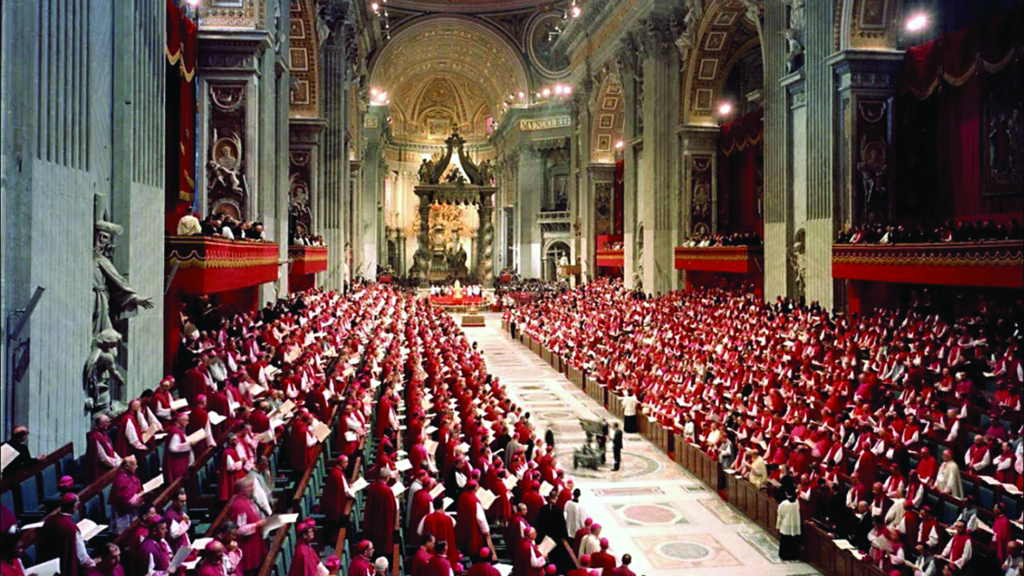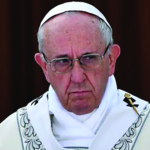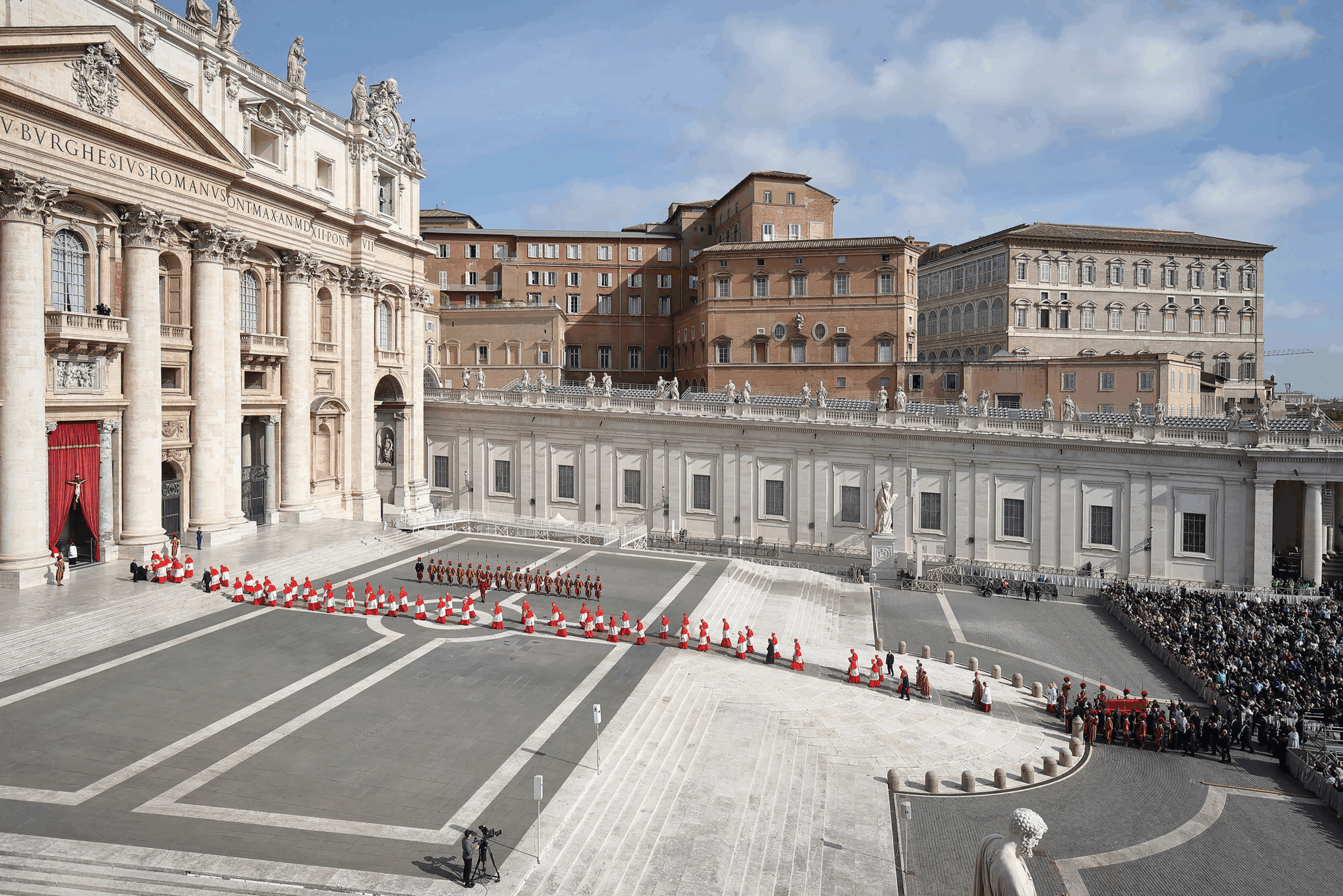Our “de facto” split threatens to spin out of control…
By Robert Moynihan

 A centrifuge spins, separating a substance into heavier and lighter parts, until what was once a united substance is divided. A centrifuge breaks things apart.
A centrifuge spins, separating a substance into heavier and lighter parts, until what was once a united substance is divided. A centrifuge breaks things apart.
We now face a centrifugal process in the Church. This process threatens to spin the Church into pieces, into various elements, along various fault lines.
And this process ought to be met by a centripetal process, which unites things, holding them together based on a fundamental unity.
And, in the case of the Church, that unity is the person of Christ Himself, and the teaching, the doctrine, that He expressed, and that was heard and recorded by His followers in the Gospels, and taught over the decades and centuries by word of mouth, and affirmed solemnly in various Councils, where a number of contested or not fully understood truths were defined.
This is our heritage.
The danger we face is that, if the Church officially splits — and there are many who already say, “we are de facto already divided” — it will not stop with just two groups of Catholics, one “progressive” and one “traditional.” No — the fissures will multiply, as at the time of the Reformation, and we will end up with 22 Catholic Churches, or 222— one here, one there, all with differing names, procedures, theologies, liturgies, hierarchies.
This will — should it occur — be a tragedy. Our consequent disunity will be a scandal to many simple faithful, a cause of mockery and laughter for some of the powerful in this world, and it will be, for the world as a whole, for humanity’s future, individually and collectively, a source and cause of great sorrow; for the unified Church, with all her flaws, has been an impediment, though often less staunch and intransigent than it could or should have been, to many grave evils.
The Church rejoices, or should rejoice, in her unity: “We believe… we all believe, as Catholic believers…”
And if the Church weeps, we should weep—if and when disunity divides us, weakens us, impedes us from doing what we are called to do in proclaiming Christ to a fallen world, a fallen world which risks falling into yet graver miseries in the months and years ahead than we have seen up until now.
This is why I believe we should do all we can to preserve our unity, our “one” Church — “one, holy, catholic” [meaning universal, everywhere, worldwide, not just in Germany, for example], apostolic [that is, holding to what was handed down by the Church Fathers, who received the faith from the Apostles themselves, mediated by the Holy Spirit].”
This does not mean to suggest that clarity on doctrine, or practice, should be muddled. We need clarity, as we do in setting out on any journey: where are we going, and how will we get there?… But it does mean to suggest that there is a need for a renewed focus on what possible way we can find to keep us united, and to prevent the centrifugal forces from shattering our unity.
In this regard, there are two matters of concern today.
Two sources of disunity
A grave problem we face in the Catholic Church today is a growing tension between the “progressive” and the “traditional” elements in the Church, threatening the unity of the Church. And this tension is presently evident in two principal matters:
(1) the Church’s liturgy;
(2) the Church’s teaching and pastoral practice concerning sexual morality, seen most strikingly in proposals being set forth now in Germany.

“What earlier generations held as sacred, remains sacred and great for us too, and it cannot be all of a sudden entirely forbidden or even considered harmful.”
-Pope Benedict XVI, Summorum Pontificum, July 7, 2007
The “old” and “new” liturgy
The struggle over the liturgy (especially the struggle over whether the embrace of the new Mass produced after the Second Vatican Council has been harmful for the Church and individual souls), has grown dangerously bitter.
In two recent letters, Pope Francis has written that the old liturgy should be strongly circumscribed, even suppressed entirely: first in his letter of July 16, 2021 (Traditionis custodes) and then, very recently, in his letter of June 29, 2022 (Desiderio desideravi).
The Pope has said the “old” liturgy has become a type of “symbol” or “rallying cry” for opposition to the Second Vatican Council (1962-65) and, therefore, he concludes, the old liturgy — in a way that was not envisioned by Pope Benedict XVI — should be diminished, not celebrated, not taught to priests, not offered to parishioners even on only rare occasions. Essentially, the old liturgy should disappear for the purpose of… increasing Church unity.
Summorum Pontificum
Pope Benedict understood these tensions.
He had wrestled with the issue of the liturgy for 50 years, or more: how to make the liturgy available and understandable to the ordinary faithful (rather than a mysterious rite in a mostly incomprehensible language) yet still keep that “link,” that “continuity,” which would acknowledge that what was being reformed was nevertheless a venerable, profound, holy rite, which had nourished the faith of untold generations, including G.K. Chesterton, John Henry Newman, Bishop John Fisher, Fr. Edmund Campion, and Sir Thomas More.
And that is why he authored Summorum Pontificum, published on July 7, 2007, proposing the coexistence of the two liturgies, old and new.
To respect the old, to accept the new, to allow for the mutual enrichment of the two forms.
That compromise is what Pope Francis (on the advice of some of his advisors, I believe) has now rejected
Excerpt from Pope Francis’ apostolic letter DESIDERIO DESIDERAVI: ON THE LITURGICAL FORMATION OF THE PEOPLE OF GOD
June 29, 2022
- … If the liturgy is “the summit toward which the activity of the Church is directed, and at the same time the font from which all her power flows,” (Sacrosanctum Concilium, n. 10), well then, we can understand what is at stake in the liturgical question. It would be trivial to read the tensions, unfortunately present around the celebration, as a simple divergence between different tastes concerning a particular ritual form. The problematic is primarily ecclesiological. I do not see how it is possible to say that one recognizes the validity of the Council — though it amazes me that a Catholic might presume not to do so — and at the same time not accept the liturgical reform born out of Sacrosanctum Concilium, a document that expresses the reality of the Liturgy intimately joined to the vision of Church so admirably described in Lumen gentium. For this reason… I have felt it my duty to affirm that “The liturgical books promulgated by Saint Paul VI and Saint John Paul II, in conformity with the decrees of Vatican Council II, are the unique expression of the lex orandi of the Roman Rite.” (Motu Proprio Traditionis custodes, art 1)
*******
In Desiderio the Pope has reiterated his intention to essentially eliminate the traditional Latin Mass and to double-down on the Novus Ordo as the “unique expression of the lex orandi of the Roman rite.” […] As a theological scholar, I utterly reject the notion that a Mass that was the lex orandi of the Church for centuries can now be summarily dismissed through papal fiat, as contrary to the “new ecclesiology” of Vatican II. Because such an idea is itself a paradigmatic expression of a legalistic and forensic understanding of the Church and of her magisterium.
– Larry Chapp, Ph.D. (“Desiderio Desideravi:
Connecting Some Papal Dots,”
National Catholic Register, July 12, 2022)
A modest proposal
The old Latin Mass could be celebrated in the vernacular, of course.
I mean, celebrate the old Latin Mass, not in Latin, but in English.
Just translate it.
I actually have proposed this on a number of occasions in Rome, to men as various as Cardinal Joseph Ratzinger, Cardinal Francis Arinze, Cardinal Malcolm Ranjith, and Archbishop Carlo Maria Viganò, in private conversations. All seemed to find it unobjectionable on theological grounds, yet so simple in practical terms they could not imagine that it could be the solution to our liturgical divisions.
I am aware of the value of keeping Latin — or any universal language, like Old Slavonic, or Hebrew — because such a “sacred language” does not change, and has the great advantage that someone from Canada could attend Mass in Japan, or someone from Vietnam could attend Mass in Italy, and everyone would be familiar with the Latin, and not feel left out. The unity of the Church would be assisted by the unity of its sacred language.
But the idea of translating the old Latin Mass does not mean that the Latin would be abandoned. In fact, just as the Council itself called for, the translated vernacular Masses could keep most of the Mass in English (or any other vernacular language), but leave parts, like the Kyrie eleison, in Greek (drawing us back in close proximity to the early Greek-speaking Christians in the catacombs of Rome), and other key prayers, perhaps the Sanctus and the Agnus dei, in the original Latin.
Such a solution would have been, in many ways, in full accord with the request of the Second Vatican Council: that the Mass be “updated” to make it more accessible to ordinary people, but not a liturgical revolution.
Translating the old liturgy into English — or any other modern language — would have accomplished the goal of greater understanding, and thus of more conscious, active participation, for those many who do not know or speak Latin.
Some will consider this proposal inadequate or objectionable for one reason or another, but it has to its credit one basic fact: it would be the same Mass, only more understandable.
And on solemn occasions, the entire old Mass could be celebrated in the ancient Latin language.
That was, and is, my own modest proposal.
What happened instead
But what happened instead was that the group of liturgists who decided to reform the old Mass in the years after the Council, in order to “update” it, decided not simply to translate it into the vernacular, but to change the prayers. This is a profound difference.
Obviously, if someone is used to saying a prayer, it becomes a part of him or her — it takes on a certain personal resonance, a type of sacrality; one becomes “invested” in the longused prayers… one “knows” them, intellectually and spiritually. Moreover, as we often say, “lex orandi, lex credendi” — “the law of praying is the law of believing” or perhaps better, “the way we pray determines what and how we believe.”
Translating a prayer does change the sound of the prayer, and may be an impoverishment if the translation is poor (“to translate is to betray,” “tradurre è tradire”), but still, the goal of translating is to give the same meaning in a different language, not a different meaning. To alter the prayer, on the other hand, changes not only the sound, and also the meaning. And this is what the liturgists did, painstakingly, in the three years after the Second Vatican Council — they changed the prayers, eliminating some, adding others, and this became the new Mass.
Now: bishops banning the TLM
Father John Zuhlsdorf, on July 14, warned that a bitter “persecution” was about to be launched against a traditional Catholic group from within the Catholic Church itself.
The next day, Fr. Zuhlsdorf updated the post to confirm that the request related specifically to Cardinal Archbishop Blase Cupich of Chicago, who instructed the Institute of Christ the King’s Chicago apostolate to cease all public activities at the end of July.
The Institute of Christ the King is a group of priests who celebrate the old rite of the liturgy, and have up until now been granted the Church’s approval to do so. This is what Cardinal Cupich is revoking.
(Cupich was named to the archbishopric of Chicago by Pope Francis over the objections of then-papal nuncio to the US, Archbishop Carlo Maria Viganò; of course, the Roman Curia makes recommendations to the Pope that may bypass the recommendations of the nuncio in the country.)
After Cardinal Cupich’s revocation of the Institute of Christ the King’s permission to celebrate the old rite in Chicago, other bishops followed suit in various ways. The same week, on July 22, Cardinal Wilton Gregory of Washington, D.C., issued a 6-page decree revoking permission for the traditional Mass at the seven parishes where it had been offered on a weekly basis — some also on a daily basis — including Old St. Mary’s, a busy neo-Gothic-style parish church built in the 19th century which for decades attracted Catholics from all over the city who preferred the old rite of Mass. Cardinal Gregory relegated remaining celebration of the TLM in his diocese to three small non-parochial churches.
And in Savannah, Georgia, Bishop Stephen Parkes announced that permission for the existence of the old Latin Mass, currently said in three parishes, will end in May of 2023.
Many other dioceses seem likely to follow, decreasing the celebration of Mass in the old rite ever more until celebration of the old rite ceases altogether. It is a strange fate for a rite that Pope Benedict XVI clearly said in Summorum Pontificum had “never been abrogated.”
The same process now seems to be underway with regard to the Church’s moral teachings: setting aside the old teachings, embracing the new ones. More on that in upcoming issues.






Facebook Comments